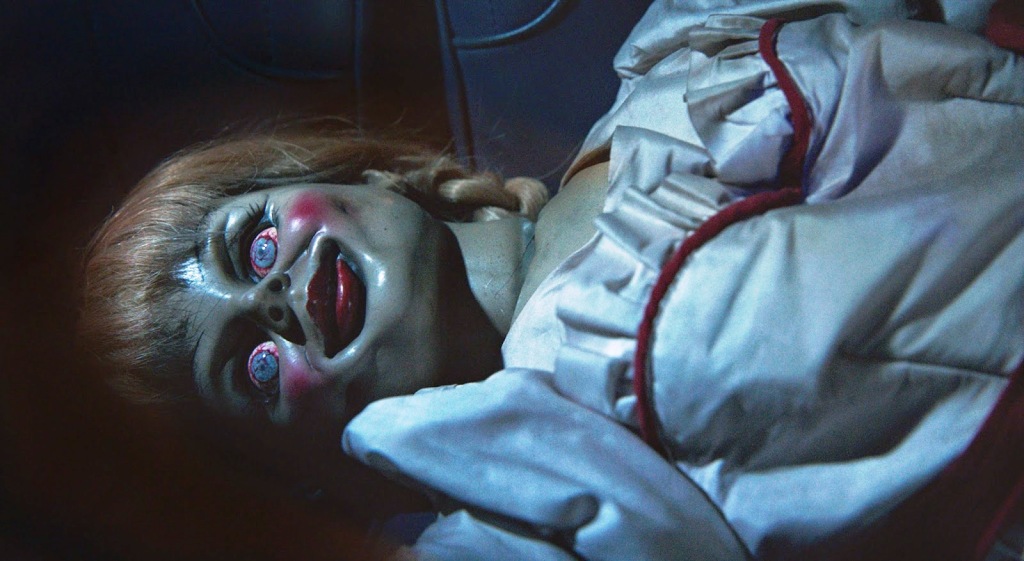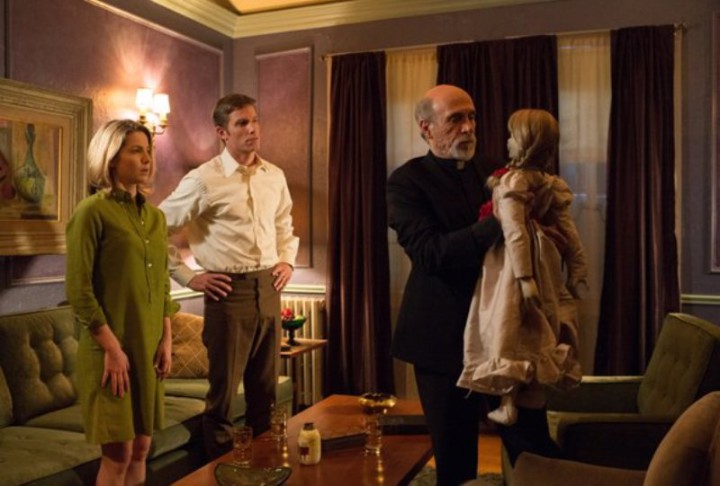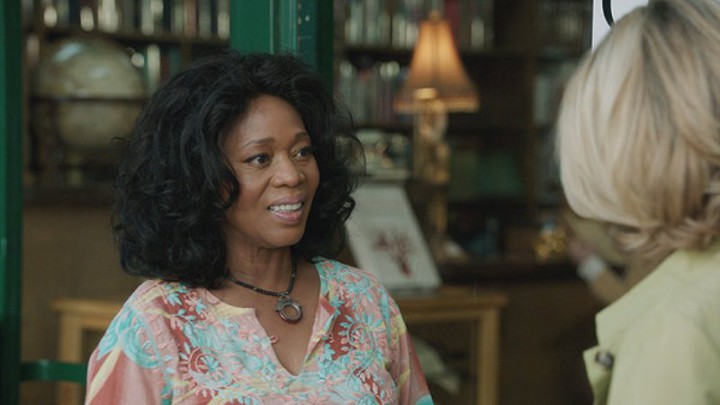I was perfectly willing to give Annabelle the benefit of the doubt. The fact that James Wan had officially retired from directing horror movies after last year’s Insidious: Chapter 2 meant someone else would be helming this spin-off of The Conjuring (2013). That turned out to be John R. Leonetti — a man with only a couple of bad features to his name. But he’d been director of photography for James Wan since 2007’s Dead Silence, so it was a case of “just maybe.” The movie itself is, unfortunately, a rather large “maybe not.” Oh, Leonetti can copy the style of Wan’s shock effects, but he lacks both Wan’s precision and his ability to generate atmosphere. It is not, by any means, entirely his fault. The screenplay by TV and direct-to-video scribe Gary Dauberman is a fairly dire hodgepodge of other — better — movies, with truly flat dialogue and long stretches of tedium. And then there’s the largely no-name cast, most of whom seem grimly determined to demonstrate why you’ve never heard of them. The sole exception is Alfre Woodard as the neighborhood bookseller and convenient demonologist-ex-machina, and even she occasionally seems perplexed by the whole thing. I can’t say I blame her much.
While it’s true that the business of the demonic Annabelle doll was probably the creepiest part of The Conjuring, the idea of an origin story is not terrifically sound. Not only is the idea that the possession has something to do with the blood of a Manson-like cult member basically warmed over from 1991’s Child’s Play 3 (which Leonetti shot), but the whole thing is predicated on the idea that someone would actually have that doll in their house in the first place. (Of course, the “real” Annabelle is just a big Raggedy Ann.) This becomes still harder to swallow once the doll is cradled by a bloody cult member, gets tossed into the trash and inexplicably reappears in a moving box at our leads’ new home, where — Chucky preserve us — they put the damn thing in the nursery. Still, it could have been a modestly effective series of shocks — and, yes, a handful of them are effective. Unfortunately, more of them are either unintentionally funny (a demon with poor aim trying to bean an infant with falling books), or are from the Satan-as-practical-joker playbook. It must take a really third-rate demon to come up with terrorizing folks by running their sewing machine. (Annabelle: Satan’s Seamstress?)
The plot is barely worth recounting, but basically it’s all about pregnant Mia (Annabelle Wallis) and John (Ward Horton) — who, one assumes, are named for Mia Farrow and John Cassavetes in Polanski’s Rosemary’s Baby (1969) — about the least interesting people imaginable. Their boring lives change when crazed Satanists (it’s 1970, you see, and Satanic cults are all the rage) enter their lives, one of whom bleeds into Annabelle, causing all the trouble. Following an unfortunate incident where now demonic Annabelle tries to Jiffy-Pop Mia to death, causing her to give birth, things get dicey. Conveniently, up-and-coming doctor John lands a plum job in Pasadena, allowing them to move with their infant daughter into the Pasadena version of the Dakota apartments, where the supposedly trashed Annabelle shows up. Spooky stuff follows, a lot of which feels like cut-rate Rosemary’s Baby until it finally becomes The Exorcist (1973) and goes full Jason Miller.
Horror movies don’t have to be realistic in order to work, but they need to at least create some kind of believable world. Despite some reasonably credible 1970 detail (the demon seems partial to The Association’s “Cherish”), the film doesn’t have this world. It exists in some weird microcosm where everyone we encounter casually accepts the existence of demonic possession — cops, a priest (an obvious runner-up in a George Carlin look-alike contest), the random bookseller. Not one single person is even mildly skeptical, but then there aren’t many people in the film’s world. No one seems to live in the apartment building but the leads — and a pair of children who may or may not be real (this goes nowhere) and some never-seen noisy upstairs neighbors, who also may not be real (shades of Michael Winner’s 1977 The Sentinel). It’s a few good shock effects and a lot of ho-hum. Rated R for intense sequences of disturbing violence and terror.








Before you comment
The comments section is here to provide a platform for civil dialogue on the issues we face together as a local community. Xpress is committed to offering this platform for all voices, but when the tone of the discussion gets nasty or strays off topic, we believe many people choose not to participate. Xpress editors are determined to moderate comments to ensure a constructive interchange is maintained. All comments judged not to be in keeping with the spirit of civil discourse will be removed and repeat violators will be banned. See here for our terms of service. Thank you for being part of this effort to promote respectful discussion.